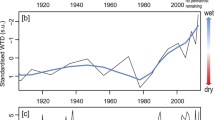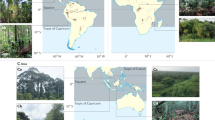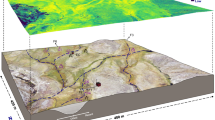Abstract
Peatlands contain approximately 25% of the total soil organic carbon, despite covering only 3% of earth’s land surface. The ecological, hydrological and biogeochemical functions of peatlands are tightly coupled to climate. Therefore, both direct human impacts and indirect effects of climate change can threaten the ecological function of peatlands through changes in hydrology. However, little is known about how peatland ecosystems, and specifically their biogeochemistry, carbon cycling, and development, may respond to climatic change. In this study, the Peat Accumulation Model was adapted to investigate the response of peatland development and carbon cycling to climatic change through simulating changes in precipitation and temperature at different stages of peatland development history. The warming and wetting were imposed on this system at 10,000 years since its initialization (mid-development stage) and at 20,000 years since its initialization (late-development stage). Here, it was revealed that peatlands can switch between carbon sinks and sources suddenly, but the extent to which the change takes place depends on the developmental stage of peatland ecosystems. The simulation results for the late-development stage showed that peatlands could function as carbon sources once warming and wetting was imposed but that peatland ecosystems during the mid-development stage can still function as carbon sinks under warming and wetting conditions. Moreover, peatland ecosystems have self-regulation capabilities so that they can go back to their normal ecological and biogeochemical functions under newly stabilized climates. Also, it is the change in temperature that results in the fundamental change in peatland development and carbon cycling. This study indicates that the response of peatland ecosystems to climate change is largely determined by their developmental stages.





Similar content being viewed by others
References
Alm J, Martikainen P, Silvola J, Schulman L, Walden J, Nykanen H (1999) Carbon balance of a boreal bog during a year with an exceptionally dry summer. Ecology 80(1):161–174
Baird AJ, Belyea LR, Morris PJ (2010) Upscaling peatland-atmosphere fluxes of carbon gases: small-scale heterogeneity in process rates and the pifalls of ‘bucket-and-slab’ models. In: Baird AJ, Belyea LR, Comas X, Reeve A, Slater L (eds) AGU monograph: Northern peatlands and carbon cycling. AGU
Balshi MS, Mcguire AD, Duffy P, Flannigan M, Kicklighter DW, Melillo J (2009) Vulnerability of carbon storage in North American boreal forests to wildfires during the 21st century. Glob Change Biol. doi:10.1111/j.1365-2486.2009.01877.x
Belyea LR, Baird AJ (2006) Beyond “The limits to peat bog growth”: cross-scale feedback in peatland development. Ecol Monogr 76(3):299–322
Belyea L, Clymo R (2001) Feedback control of the rate of peat formation. Proc R Soc Lond B 268:1315–1321
Belyea LR, Malmer N (2004) Carbon sequestration in peatland: patterns and mechanisms of response to climate change. Glob Change Biol 10(7):1043–1052
Bridgham SD, Updegraff K, Pastor J (1998) Carbon, nitrogen, and phosphorus mineralization in northern wetlands. Ecology 79:1545–1561
Bridgham SD, Megonigal JP, Keller JK, Bliss NB, Trettin C (2006) The carbon balance of North American wetlands. Wetlands 26:889–916
Bridgham SD, Pastor J, Dewey B, Weltzin JF, Updegraff K (2008) Rapid carbon response of peatlands to climate change. Ecology 89(11):3041–3048
Bubier JL, Frolking S, Crill PM, Linder E (1999) Net ecosystem productivity and its uncertainty in a diverse boreal peatland. J Geophys Res 104(D22):27683–27692
Charman D (2002) Peatlands and environmental change. John Wiley & Sons, Chichester
Clymo R (1984) The limits to peat bog growth. Philos Trans R Soc B 303:605–654
Clymo R (1992) Models of peat growth. Suo 43:127–136
Clymo R, Turunen J, Tolonen K (1998) Carbon accumulation in peatland. Oikos 81:368–388
Denman K, Brasseur G, Chidthaisong A, Ciais P, Cox P, Dickinson RE, Hauglustaine D, Heinze C, Holland E, Jacob D, Lohmann U, Ramachandran S, da Silva Dias PL, Wofsy SC, Zhang X (2007) Coupling between changes in the climate system and biogeochemistry. In: Solomon S, Qin D, Manning M et al (eds) Climate change 2007: the physical science basis. Contribution of Working Group I to the Fourth Assessment Report of the Intergovernmental Panel on Climate Change. Cambridge University Press, Cambridge, UK
Dise NB (2009) Peatland response to global change. Science 326(5954):810–811. doi:10.1126/science.1174268
Fraser CJD, Roulet NT, Lafleur M (2001a) Groundwater flow patterns in a large peatland. J Hydrol 246(1–4):142–154
Fraser CJD, Roulet NT, Moore TR (2001b) Hydrology and dissolved organic carbon biogeochemistry in an ombrotrophic bog. Hydrol Process 15(16):3151–3166
Frolking S, Bubier JL, Crill PM, Roulet NT, Moore TR, Lafleur PM (2002) Modeling seasonal to annual carbon balance of Mer Bleue Bog, Ontario, Canada. Glob Biogeochem Cycle 16 (3). doi:10.1029/2001GB1457
Frolking S, Roulet NT, Fuglestvedt J (2006) How Northern peatlands influence the Earth’s radiative budget: sustained methane emission versus sustained carbon sequestration. J Geophys Res 111 (G01008). doi:10.1029/2005JG000091
Frolking S, Roulet N, Lawrence D (2010) Issues related to incorporating northern peatlands into global climate models. In: Baird AJ, Belyea LR, Comas X, Reeve A, Slater L (eds) AGU monograph: Northern peatlands and carbon cycling. AGU
Gajewski K, Wilson S, Viau A, Sawada M, Atkinson D (2001) Sphagnum peatland distribution in North America and Eurasia during the past 21, 000 years. Glob Biogeochem Cycle 15(2):297–310
Gedney N, Cox PM (2003) The sensitivity of global climate model simulations to the representation of soil moisture heterogeneity. J Hydrometeorol 4(6):1265–1275
Gedney N, Cox PM, Huntingford C (2004) Climate feedback from wetland methane emissions. Geophys Res Lett 31(20):L20503 20501–L20503 20504
Gignac L, Vitt D (1994) Responses of northern peatlands to climate change: effects on bryophytes. J Hattori Bot Lab 75:119–132
Gignac LD, Halsey LA, Vitt DH (2000) A bioclimatic model for the distribution of Sphagnum-dominated peatlands in North America under present climatic conditions. J Biogeogr 27(5):1139–1151
Glaser PH, Hansen BCS, Siegel DI, Reeve AS, Morin PJ (2004) Rates, pathways and drivers for peatland development in the Hudson Bay Lowlands, northern Ontario, Canada. J Ecol 92(6):1036–1053
Gorham E (1991) Northern Peatlands—Role in the Carbon-Cycle and Probable Responses to Climatic Warming. Ecol Appl 1(2):182–195
Halsey L, Vitt D, Zoltai S (1997) Climatic and physiographic controls on wetland type and distribution in Manitoba, Canada. Wetlands 17(2):243–262
Halsey LA, Vitt DH, Bauer IE (1998) Peatland initiation during the holocene in continental western Canada. Clim Change 40(2):315–342
Hilbert DW, Roulet N, Moore T (2000) Modelling and analysis of peatlands as dynamical systems. J Ecol 88(2):230–242
Ingram HAP (1982) Size and shape in raised mire ecosystems: a geophysical model. Nature 297(5864):300–303
IPCC (ed) (2007) Climate change 2007: the physical science basis. Contribution of Working Group I to the Fourth Assessment Report of the Intergovernmental Panel on Climate Change. Cambridge University Press, Cambridge, UK
Ise T, Dunn AL, Wofsy SC, Moorcroft PR (2008) High sensitivity of peat decomposition to climate change through water-table feedback. Nat Geosci 1(11):763–766. doi:10.1038/ngeo331
Ivanov KE (1981) Water movement in mirelands (trans: Thompson A, Ingram HAP). Academic press, London
Kennedy GW, Price JS (2005) A conceptual model of volume-change controls on the hydrology of cutover peats. J Hydrol 302(1–4):13–27
Lafleur PM (1993) Potential water-balance response to climatic warming—the case of a coastal wetland ecosystem of the James Bay lowland. Wetlands 13(4):270–276
Lafleur P, Roulet N (1992) A comparison of evaporation rates from 2 fens of the Hudson Bay lowland. Aquat Bot 44:59–69
Lafleur PM, Roulet NT, Bubier JL, Frolking S, Moore TR (2003) Interannual variability in the peatland-atmosphere carbon dioxide exchange at an ombrotrophic bog. Glob Biogeochem Cycle 17(2). doi:10.1029/2002gb001983
Limpens J, Berendse F, Blodau C, Canadell JG, Freeman C, Holden J, Roulet NT, Rydin H, Schaepman-Strub G (2008) Peatlands and the carbon cycle: from local processes to global implications—a synthesis. Biogeosciences 5:1475–1491
Luo Y, Gerten D, Le Maire G, Parton WJ, Weng E, Zhou X, Keough C, Beier C, Ciais P, Cramer W, Dukes JS, Emmett B, Hanson PJ, Knapp A, Linder S, Nepstad DAN, Rustad L (2008) Modeled interactive effects of precipitation, temperature, and CO2 on ecosystem carbon and water dynamics in different climatic zones. Glob Change Biol 14(9):1986–1999. doi:10.1111/j.1365-2486.2008.01629.x
Meehl GA, Stocker TF, Collins WD, Friedlingstein P, Gaye AT, Gregory JM, Kitoh A, Knutti R, Murphy JM, Noda A, Raper SCB, Watterson IG, Weaver AJ, Zhao Z-C (2007) Global climate projections. In: Solomon S, Qin D, Manning M et al. (eds) Climate change 2007: the physical science basis. Contribution of Working Group I to the Fourth Assessment Report of the Intergovernmental Panel on Climate Change. Cambridge University Press, Cambridge, UK
Mitra S, Wassmann R, Vlek P (2005) An appraisal of global wetland area and its organic carbon stock. Curr Sci 88:25–35
Moore T, Dalva M (1993) The influence of temperature and water table position on carbon dioxide and methane emissions from laboratory columns of peatland soils. J Soil Sci 44:651–664
Moore TR, Roulet NT, Waddington JM (1998) Uncertainty in predicting the effect of climatic change on the carbon cycling of Canadian peatlands. Clim Change 40(2):229–245
Moore TR, Roulet NT, Bubier JL, Frolking SE, Lafleur PM (2002) Plant biomass and production and CO2 exchange in an ombrotrophic bog. J Ecol 90(1):25–36
Petrone RM, Waddington JM, Price JS (2001) Ecosystem scale evapotranspiration and net CO2 exchange from a restored peatland. Hydrol Process 15(14):2839–2845
Robroek BJM, Schouten MGC, Limpens J, Berendse F, Poorter H (2009) Interactive effects of water table and precipitation on net CO2 assimilation of three co-occurring Sphagnum mosses differing in distribution above the water table. Glob Change Biol 15(3):680–691
Roulet N (2000) Peatlands, carbon storage, greenhouse gases, and the Kyoto protocol: prospects and significance for Canada. Wetlands 20(4):605–615
Roulet N, Munro DS, Mortsch L (1997) Wetlands. In: Bailey WG et al (eds) The surface climate of Canada. McGill-Queen’s University Press, Montreal, pp 149–171
Roulet N, Lafleur PM, Richard PJH, Moore T, Humphreys ER, Bubier J (2007) Contemporary carbon balance and late holocene carbon accumulation in a northern peatland. Glob Change Biol 13:397–411. doi:10.1111/j.1365-2486.2006.01292.x
St-Hilaire F, Wu J, Roulet NT, Frolking S, Lafleur PM, Humphreys ER, Arora V (2008) McGill wetland model: evaluation of a peatland carbon simulator developed for global assessments. Biogeosci Discuss 5:1689–1725
St-Hilaire F, Wu J, Roulet NT, Frolking S, Lafleur PM, Humphreys ER, Arora V (2010) McGill wetland model: evaluation of a peatland carbon simulator developed for global assessments. Biogeosciences 7(11):3517–3530. doi:10.5194/bg-7-3517-2010
Turetsky MR (2004) Decomposition and organic matter quality in continental peatlands: the ghost of permafrost past. Ecosystems 7(7):740–750. doi:10.1007/s10021-004-0247-z
Turunen J, Tomppo E, Tolonen K, Reinikainen A (2002) Estimating carbon accumulation rates of undrained mires in Finland—application to boreal and subarctic regions. Holocene 12(1):69–80
Waddington JM, Griffis TJ, Rouse WR (1998) Northern Canadian wetlands: net ecosystem CO2 exchange and climatic change. Clim Change 40(2):267–275
Wang X, Li X, Hu Y, Lü J, Sun J, Li Z, He H (2010) Potential Carbon Mineralization of Permafrost Peatlands in Great Hing’an Mountains, China. Wetlands 30(4):747–756. doi:10.1007/s13157-010-0075-1
Wu J (2009) Simulating northern peatland-atmosphere carbon dioxide exchange with changes in climate. PhD thesis, McGill University, Montreal
Yu Z (2011) Holocene carbon flux histories of the world’s peatlands: global carbon-cycle implications. Holocene. doi:10.1177/0959683610386982
Yu Z, Apps MJ, Campbell ID, Vitt DH (2001a) Modelling long-term peatland dynamics. I. Concepts, review, and proposed design. Ecol Model 145(2-3):197–210
Yu Z, Turetsky MR, Campbell ID, Vitt DH (2001b) Modelling long-term peatland dynamics. II. Processes and rates as inferred from litter and peat-core data. Ecol Model 145(23):159–173
Yu ZC, Campbell ID, Campbell C, Vitt DH, Bond GC, Apps MJ (2003a) Carbon sequestration in western Canadian peat highly sensitive to Holocene wet-dry climate cycles at millennial timescales. Holocene 13(6):801–808
Yu ZC, Vitt D, Campbell I, Apps M (2003b) Understanding Holocene peat accumulation pattern of continental fens in western Canada. Can J Bot 81(3):267–282
Yu Z, Loisel J, Brosseau DP, Beilman DW, Hunt SJ (2010) Global peatland dynamics since the Last Glacial Maximum. Geophys Res Lett 37 (13):L13402. doi:10.1029/2010gl043584
Zoltai S, Vitt D (1990) Holocene climatic change and the distribution of peatlands in western interior Canada. Quat Res 33(2):231–240
Acknowledgments
A special thank is given to Dr. Nigel Roulet, Dept. of Geography, McGill University, for providing me with the original code of the PAM and helping me design the climate change scenarios. I wish to express sincere thanks to the two anonymous reviewers for providing me with the insightful comments that greatly improved this manuscript. I also wish to extend my special thanks to Dr. Stephanie McKenzie, Associate Professor, Dept. of English, MUN (Grenfell Campus), for copyediting this manuscript. This research was funded by the CGC3M research network and Fluxnet-Canada, as well as the Principal’s Research Fund and Start-up funding at Grenfell Campus, Memorial University of Newfoundland. GEC3 student travel funds, a Fluxnet-Canada student travel grant, and the Chinese Academy of Forestry funded me to present this research at the International Conference on Forest and Water in a Changing Environment, Beijing, China.
Author information
Authors and Affiliations
Corresponding author
Rights and permissions
About this article
Cite this article
Wu, J. Response of peatland development and carbon cycling to climate change: a dynamic system modeling approach. Environ Earth Sci 65, 141–151 (2012). https://doi.org/10.1007/s12665-011-1073-1
Received:
Accepted:
Published:
Issue Date:
DOI: https://doi.org/10.1007/s12665-011-1073-1




